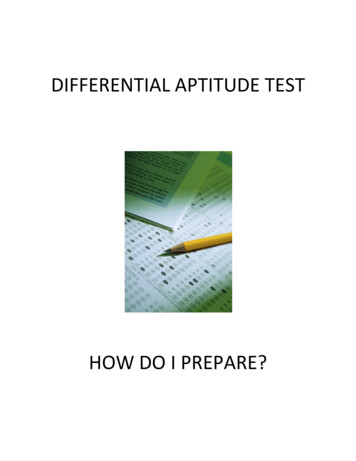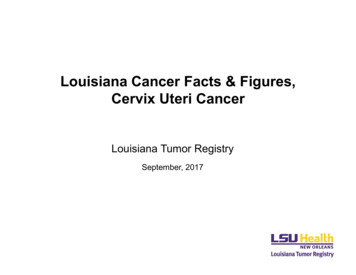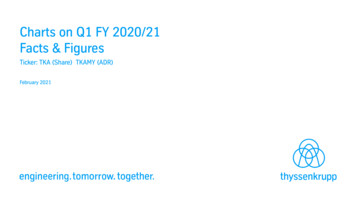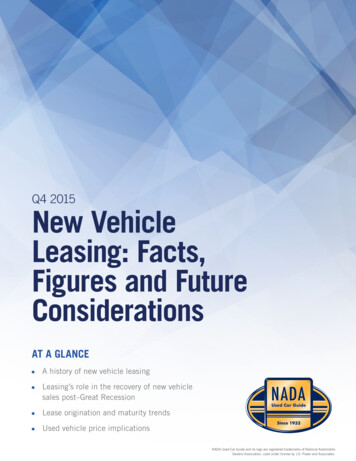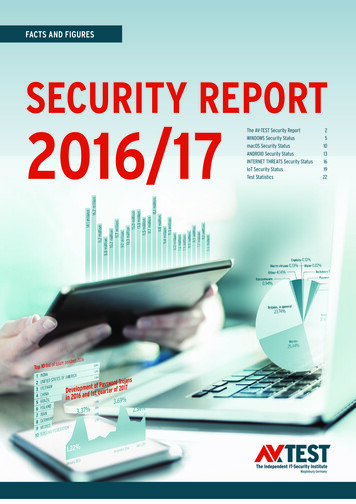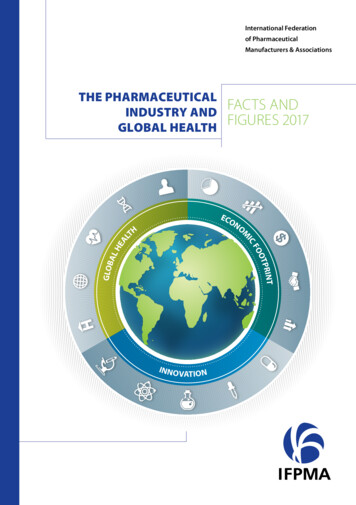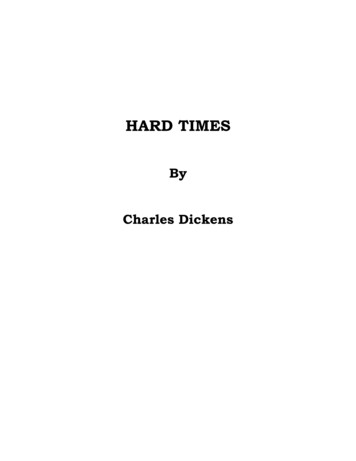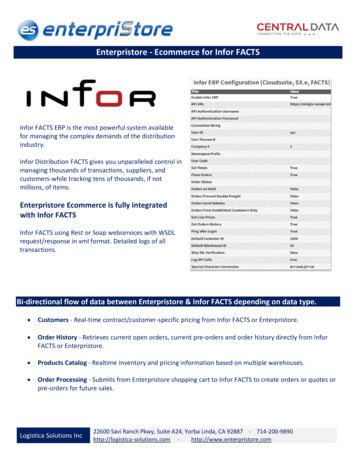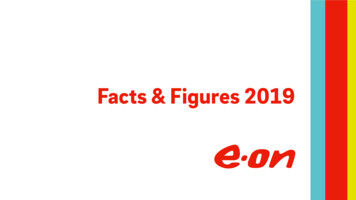
Transcription
Facts & Figures 2019
Content1. Overview22.Energy Networks73.Customer nancials96
E.ON at a glanceKey financials2018Group EBIT1 3.0bnCore EBIT1 2018Customer SolutionsEnergy NetworksShare of regulated/long-term contractedbusinesses2RenewablesAdj. Net Income1 1.5bn1. Adjusted for non operating effects2. Percentage as of Group EBIT 0.4bn 1.8bn 0.5bnRegulated/contractedMerchant3
E.ON portfolioEnergy NetworksSwedenCustomerSolutionsCEE1/ TurkeyGermanyGermanyUKOtherRenewablesOnshore Wind/ PV2Offshore Wind/ OtherCore businesses1. Central and Eastern Europe2. PhotovoltaicPreussenElektraTurkey GenerationNon-corebusiness4
Attractive combination of businessesEnergy Networks 20 bn Regulated Asset Base1Germany 10.5 bnSweden 3.7 bnCEE² & Turkey3 5.8 bn 1.4 m Smart Meters rolledout in our grid areasIn total more than 10 m SmartMeters to be rolled out until 2032 47 GW RES4 capacityconnectedCustomer Solutions 22 m Customers across EuropeGermany 6.0 mUK 6.6 mOther EU 9.4 m5 30%of Adj. EBIT6 from CityEnergy Solutions7Resilience from long-termcustomer relations built onsatisfaction and trustFast growingEnergy solutions businesses forconsumers as well as forindustrial and commercialcustomersRenewables 7.5 GW Renewables capacitydelivered since 20078 projects Under construction8 1.3 GW total gross capacity9of projectsunder construction &repowering 12 bn Investments1012 year track record ofrenewables development,construction and operations14.7 TWh Green Electricityproduced in 20181. In general, Net RABs from different regulatory regimes are not directly comparable due to significant methodical differences. These include for example different regulatory asset lifetimes, assetvaluation methods, or treatment of customer contributions for network connections. 2. 100% view for Slovakia 3. 100% view for Turkey 4.Renewables 5. Including Slovakia 6. Adjusted for non-operatingeffects 7. Former segment Heat 8. As of 31 December 2018 9. Including one repowering project 10. Net economic investments since 20175
E.ON Board of ManagementLeonhard BirnbaumChief Operating OfficerJohannes TeyssenChief Executive Officer Strategy & Portfolio Human Resources Communications &Political Affairs Legal & Compliance Corporate Audit TurkeyMarc SpiekerChief Financial OfficerIntegration Finance Investor Relations Mergers & Acquisitionsand ParticipationManagement Risk Management,Accounting &Controlling TaxThomas KönigChief Operating Officer innogy integrationproject Renewables Sustainability &HSE PreussenElektraNetworks Energy Networks Procurement ConsultingKarsten WildbergerChief Operating OfficerCommercial Customer Solutions DecentralizedGeneration Energy Management Marketing Digital Transformation Innovation IT6
Content1.Overview2. Energy Networks273.Customer nancials96
Energy NetworksEnergy NetworksRegulated asset base 20181Grid length (‘000 km) 1 Grid length: 980Germany 10.5bnSweden 3.7bn Grid length: 96493350 20.0bn251CEE &Turkey 5.8bnGermanyEBIT3 2018Sweden 0.5bnCEE &Turkey 0.4bn138 1.8bn450SwedenCEE & TurkeyMarket share (%) 71% ofgroupcore19Germany 0.9bn1. 100% view for Slovakia and Turkey (Enerjisa Enerji)2. Differences may occur due to rounding.3. Adjusted for non operating effects4. Arithmetic averagePower and gas businessPower business only2412GermanyPowerSweden3227CEE & Turkey4Gas8
Energy Networks at a glanceEnergy NetworksWhat we do Within Energy Networks we provide the infrastructure forthe new energy world. We manage the grids at the high,medium and low voltage levels.Power and gas distribution is predominantly a regulatedbusiness in our countries of operationWe have a strong network presence in power and gas inour core markets17,900 employees work in Energy 2n/a961.61.70.80.619GermanySwedenHungaryCzech Republic10737181489215335013884Grid length gas ('000km)51n/aRAB power & gas ( bn)310.53.7Wheeling volumes power (TWh)Wheeling volumes gas (TWh)Grid length power ('000km)22Romania1921. Slovakia is not consolidated in E.ON financial statements (here: 100% view).2. Small differences in reported total figures may occur due to rounding.3. In general, Net RABs from different regulatory regimes are not directly comparable due to significant methodical differences. These include for example different regulatory asset lifetimes,asset valuation methods or treatment of customer contributions for network connections. RAB Slovakia and Sweden only includes power.9
Energy Networks: Financial highlightsEnergy Networks2017 mSales2Adjusted EBITDA3Adjusted EBIT3Investments (cash-effective)Regulatory 1,1414652653971,1271. Turkey (Enerjisa Enerji) and Slovakia included as an at equity participation (i.e. with net income result)2. The presentation of sales (and costs of materials) in 2018 was substantially affected by the initial application of IFRS 15, Revenue from Contracts with Customers 3. Adjusted for non-operating effects4. Turkey (Enerjisa Enerji) not included; Slovakia 100% viewTotal10
Energy Networks: Earnings components2018Total EBITDA ( bn)Components of total EBITDA ( %)Regulated earningsthereof regulatory depreciationNon-regulated earningsIncome from participations2018Germany1.49Energy wedenCEE1Total EBIT ( bn)Components of total EBIT ( %)0.90.50.35Regulated earningsNon-regulated earningsIncome from participations84313933496311. CEE figures include Czech, Hungary and Romania. In case of Hungary effects of Utility Tax have been excluded.
Energy Networks Germany – Results from participations 2018CompanyEnergy NetworksAt equity consolidationStädtische Werke Magdeburg GmbH & Co. KGEnergie und Wasser Potsdam GmbHGASAG AGREWAG Regensburger Energie- und Wasserversorgung AG & Co. KGStadtwerke Brandenburg an der Havel GmbH & Co. KGGasversorgung Unterfranken GmbHSWS Energie GmbHLSW Holding GmbH & Co. KGOtherAt cost consolidationSERVICE plus GmbHGasLINE Telekommunikationsnetzgesellschaft deutscher Gasversorgungsunternehmen mbH & Co. KG.infra fürth GmbHOtherContribution to E.ON result 2018 ( m)691313108543310387622312
Upcoming regulatory periodsEnergy NetworksGermany 2019 - 2023Romania 2019 - 2023Sweden 2020 - 2023Hungary 2021 - 2024PowerCzech Republic 2021 - 20251Slovakia 2022 - ia 2019 - 2023Hungary 2021 - 2024GasCzech Republic 2021 - 20251Germany 2023 - 20271. Length of upcoming regulatory period still under discussion13
Content1.Overview22.Energy Networks72.1 Germany143.Customer nancials96
Energy Networks: GermanyGermanyGrid lengthPower ('000km)Market share (%)Gas ('000km)1Market share (%)2017Energy Networks20182017201810811110.71078910.5Grid conduct349196012350195110Wheeling volumes power (TWh)2Wheeling volumes gas (TWh)RAB power & gas ( bn)3Major shareholdingsAvacon AGBayernwerk AGE.DIS AGHanseWerk AG61.5%100%67.0%66.5%1. Divestment of Hamburg Gas Grid in 20182. Wheeling Volumes include High Voltage (110kV)3. Pro forma RAB - not applicable for current regulatory period in power and gas; applicable RAB for current regulatory period is RAB of year 2011 (power): 7.3bn / 2015 (gas): 2.3bn15
German business with roughly 5,400 concessionsGood track record in the pastEnergy NetworksExisting concessions The German networks business is based on long-term concessionsgranted by municipalities in the network areaNon-concessionbased RAB1 Maximum period of concession contract is 20 years 30% 70%Expiringconcessions in %of revenue cap40%20%30%5%5%currentlyopenTODAY1. Includes for example 110 kV gridConcessionbased RAB 5 years5 - 10years10 - 15years 15 years203816
Regulatory environment Germany: Power & GasEnergy NetworksProcess steps of regulatory system1BasicsCost audit BenchmarkingAnnualrevenue capGrid expansion /Adjustment of capitalcostsNetwork tariffevery 5 yearsannual adjustmentannual adjustmentannual adjustment Method: Revenue cap (incentive regulation) Regulatory period: 5 years - power: 2nd regulatory period: 2014-2018, 3rd reg. period: 2019-2023- gas: 3rd regulatory period: 2018-2022 Cost audit and benchmarking (for Opex/capital costs) once per regulatory period Total costs of historic base year (three years prior to start year of new regulatory period) basis forbenchmarking & revenue cap Annual adjustment of revenue cap by Consumer Price Index (CPI) General efficiency factor for power of 1.5% in 2nd regulatory period and 0.9% in 3rd regulatoryperiod; general efficiency factor for gas 0.49% in 3rd regulatory period; individual efficiencyfactors based on benchmarking result Power: Additional revenue allowance for grid expansion (grid replacement not considered) in 2ndregulatory period. From 3rd regulatory period onwards: Annual adjustment of RAB for investments (growth/replacement)and regulatory depreciation ( true up ) leads to annual adaptation of capital costs Based on revenue cap, estimated energy consumption and revenue differences (toohigh/ low) from prior years1. Please note, that the information provided is a simplified version of the German regulatory framework.17
Germany: Regulatory schedulePower distribution1 - Illustration2nd regulatory periodCommentary3rd regulatory periodCapital costsAllowed capital costs increase dueto higher investments abovedepreciationOpexOpexCapital costsReduction of allowed regulatoryinterest rates in 3rd periodEnergy Networks2011 2012 2013 2014 2015 2016 2017 2018 2019 2020 2021 2022 2023Revenue cap (individual efficiency 100%)Opex allowanceActual OpexCapital cost allowanceActual capital costs2nd regulatory period: Opex and regulatory capital costs of base year 2011 are basisfor allowed revenues from 2014 till 201813rd regulatory period: Opex of base year 2016 are basis for allowed revenues from2019 onwards1 Annual adjustment of RAB for investments(growth/replacement) and regulatory depreciation ( true up )leads to annual adaptation of capital costs Capital costs of base year 2016 for investments from 2007to 2016 are kept constant in the 3rd regulatory period asinterim solution due to change of regulatory systemAdditional capital costs for new investments1. For gas the base year for the third regulatory period is 2015. The third regulatory period started in 2018.18
Germany: Building blocks of allowed revenuesEnergy Networks 9.6 bn 0.6 bn 1.7 bnTotex indexed toCPI and subject togeneral and individualefficieny targets 2.2 bn 4.7 bnthereof 4.2 bn powerOpex40% Cap 0.5 bn gasAllowed revenuesPass-through items(charges of higher gridlevels, pensions, etc )Lagged recoveries(netting of actual vs.allowed revenues)Adjustment of revenues(grid expansion (power),capital costs (gas), qualitybonus/penalty )Total allowed cost base(Totex)Operating costsallowance(based on actual costs ofhistoric base year)Depreciation allowanceTrade tax allowanceReturn on excessive equity 4% (power) / 3% (gas)for equity in excess of 40%Return on equity3Old assets: 7.14 / 5,12%New assets: 9.05 / 6.91%CapitalCostsRegulated equity base(related to regulatorycapital structure,maximum 40%)Debt base2(related to actual capitalstructure, minimum60%) 5.1 bnRegulated asset base1Old assets: Current costs;New assets: Historic costsPower(Old)Power(New)Gas Gas1(Old) (New)Schematic illustration for 2018 (power & gas)1. Old assets are those capitalized before January 1, 2006. New assets are those capitalized after January 1,2006. Old assets are indexed up to 40% with asset-specific indices todetermine the current costs. Relevant asset base for calculation of allowed return in 2018 is 2011 for power and 2015 for gas2. Debt base consists of non-interest and interest bearing capital3. Return on equity rate is post trade tax and pre corporate tax. Old assets: 7.14% (power) and 5.12% (gas), new assets 9.05% (power) and 6.91% (gas)19
Germany: Determination of regulatory returnsRegulatory returns in German power networksEquity returnAsset shareBase rateMarket premiumBetaLevered BetaEquity return after taxEquity return pre taxEquity return pre corporate taxCost of debt (for equity above 40%)pre taxpost taxWACC2pre taxpost taxTax rateCorporate taxTrade taxFinancing structure3EquityDebt2nd regulatory periodNew assetsOld .40%5.84%10.49%8.27%9.05%7.14%1Energy Networks3rd regulatory period4New assetsOld 40%60%4.01%2.83%4.42%3.12%1. Old assets are those capitalized before January 1, 2006. New assets are those capitalized after January 1, 2006. Old assets are indexed up to 40% with asset-specific indices to determinethe current costs. 2. Weighted average cost of capital. The German regulator does not use a WACC-approach. The pro-forma WACC can be used to compare German regulatory returns internationally.In Germany, the regulator determines an allowed return on equity (RoE). 3. Interest free liabilities (such as construction grants) not considered 4. E.ON DSOs filed an appeal against BNetzA decision .20
Content1.Overview22.Energy Networks72.2 Sweden213.Customer nancials96
Energy Networks: SwedenSweden1Grid lengthPower ('000km)Market share (%)Gas ('000km)Market share (%)Major shareholdingsE.ON Energidistribution Sverige ABE.ON Gas Sverige AB201713725271Energy Networks201813825n/an/aGrid conductWheeling volumes power (TWh)Wheeling volumes gas (TWh)RAB power & gas ( bn)2201720183744.03723.7100%0%1. Disposal of gas grid in 20182. RAB figures converted at a SEK/EUR rate of 9.63 (2017) and 10.26 (2018); RAB value for 2018 only shows Power RAB, Power RAB 2017 was 3.8bn22
Regulatory environment Sweden: PowerOverviewKey cost factorsBasics Method: Revenue capRegulatory period: 2016-2019Next regulatory period: 2020-2023Photo year for Opex allowance: Four year averageInflation adjustment: OpexCapex Regulatory return (WACC) on RAB (pre-tax, real): 5.85% Adjustment of RAB once a period: Standard prices set by regulatorapplied to recognized historic assets planned assets according topublished action plans, minus disposals and depreciation Depreciation period for power lines, cables and stations is 40 years and10 years for meters and IT-systemsOpexCap formula1 Revenue cap (Controllable costs x (PI - efficiency factor)) non-controllable costs (age adjusted value (number of recognized assets and planned assets xregulatory standard prices)) x WACC depreciation2,3 /- qualityadjustmentOther important factors 1.2.3.4.Energy Networks Historical average costs 2010-2013 indexed to 2014Opex annually adjusted for inflation (PI)Inflation factor (PI) is the industry specific price indexEfficiency factor: 1% p. a.Non-controllable costs are pass-through; one to one reflected in therevenue capQuality adjustment considers outages above 3 minutes and below 12 hrs and incentives for grid lossesRES4 connections are cash neutral and included in revenue capThe cap formula is an E.ON internal interpretation of the national regulatory framework.No assets older than 38 years in the regulatory model, but additional depreciation and return allowed for assets built before 1977, for a period of 12 yearsAverage regulatory depreciation (2018-2020): 270 m p. a.Renewables23
Content1.Overview22.Energy Networks72.3 CEE243.Customer nancials96
Energy Networks: Czech RepublicCzech Republic2017Energy Networks2018Grid length201720181414Grid conductPower ('000km)1Market share (%)1Gas ('000km)Market share (%)6566Wheeling volumes power (TWh)2828Wheeling volumes gas (TWh)5656RAB power and gas ( bn)2431.61.7Major shareholdingsE.ON Distribuce, a.s.100%1. Preliminary figures for 20182. RAB figures converted at a CZK/EUR rate of 26.33 (2017) and 25.65 (2018)25
Regulatory environment Czech Republic: PowerOverviewBasicsMethod: Revenue capRegulatory period: 2016-2020Next regulatory period1: 2021-2025Photo year for Opex allowance: 3 year average (based on past practice;the laws do not provide for an explicit mechanism) Inflation adjustment: Opex Cap formula2 Revenue cap Controllable costs x (PI - efficiency factor) non-controllable costs (RAB x WACC) depreciation3 Quality bonus/malus Market factorOther important factors Energy NetworksKey cost factorsCapex Regulatory return (WACC) on RAB (pre-tax, nominal): 7.95% Depreciation period for power lines is 40 years Annual adjustments of RAB for depreciation and planned investments (notime lag)Opex Historical average costs 2012-2013 Opex annually adjusted for inflation (PI) Inflation factor (PI) for Opex is 70% business service price index 30%(CPI 1%) General efficiency factor: 1.0% annually Individual efficiency factor: 0% for the current regulatory period100% of customer driven investment costs recognized in the RAB80% of customer contributions to investment costs deducted from allowed revenues distributed over 20 years1. Not legally set, anticipated based on past experience2. The cap formula is an E.ON internal interpretation of the national regulatory framework3. Average regulatory depreciation (2018-2020) for power and gas: 124m p. a.26
Regulatory environment Czech Republic: GasOverviewBasicsMethod: Revenue capRegulatory period: 2016-2020Next regulatory period1 : 2021-2025Photo year for Opex allowance: 3 year average (based on past practice;the laws do not provide for an explicit mechanism) Inflation adjustment: Opex Cap formula2 Revenue cap Controllable costs x (PI - efficiency factor) non-controllable costs (RAB x WACC) depreciation3 Market factorOther important factors Energy NetworksKey cost factorsCapex Regulatory return (WACC) on RAB (pre-tax, nominal): 7.94% Depreciation period for gas pipes is 40 years Annual adjustments of RAB for depreciation and planned investments (notime lag)Opex Historical average costs 2012-2013 Opex annually adjusted for inflation (PI) Inflation factor (PI) for Opex is 70% business service price index 30%(CPI 1%) General efficiency factor: 1.0% annually Individual efficiency factor: 0% for the current regulatory period100% of customer driven investment costs recognized in the RAB80% of customer contributions to investment costs deducted from allowed revenues with 20 year time distribution1. Not legally set, anticipated based on past experience2. The cap formula is an E.ON internal interpretation of the national regulatory framework3. Average regulatory depreciation (2018-2020) for power and gas: 124m p. a.27
Energy Networks: HungaryHungary2017Energy Networks2018Grid lengthPower ('000km)8584Market share (%)Gas ('000km)52185218Market share (%)2123Grid conductWheeling volumes power (TWh)Wheeling volumes gas (TWh)RAB power and gas ( bn)1201720181818151.7151.6Major shareholdingsE.ON Dél-dunántúli Áramhálózati Zrt.E.ON Észak-dunántúli Áramhálózati Zrt.E.ON Tiszántúli Áramhálózati Zrt.E.ON Dél-dunántúli Gázhálózati Zrt.E.ON Közép-dunántúli Gázhálózati Zrt.100%100%100%99.96%99.84%1. RAB figures converted at a HUF/EUR rate of 309.7 (2017) and 318.9 (2018)28
Regulatory environment Hungary : PowerOverviewKey cost factorsBasics Method: Modified revenue cap with actual quantity acceptance with twoyear time lag Regulatory period: 2017-2020 Next regulatory period: 2021-2024 Photo year for Opex allowance: Two years prior to the start year of thenew regulatory period Inflation adjustment: Opex; RABCap formula1 Modified revenue cap (Allowed controllable costs non-controllable costs (RAB x WACC) depreciation2 quality adjustment) / forecasted volume3 Qualitybonus/ malusEnergy NetworksCapex Regulatory return (WACC) on RAB (pre-tax, real): 4.69%Annual adjustments of RAB for inflation (CPI) and depreciationSmart grid investments get a 1.1 return multiplierDepreciation period for power lines is 37 yearsOpex Historical costs 2015 Opex annually adjusted for inflation (CPI)Other important factors Quality factor for unplanned SAIDI4, SAIFI4 and an outage rate min. level defined. Sanctions possible if non-compliant in 3-years averageAdditional revenues granted for RES5 integration and connection of economy boosting investments (i.e. connection of industry parks)Public utility tax (125 HUF/meter of grid) and Robin Hood tax (31% of tax base) not recognized as eligible costs in the network tariffs1. The cap formula is an E.ON internal interpretation of the national regulatory framework. 2. Average regulatory depreciation (2018-2020) for power and gas: 116 m p. a. 3. Actualvolumes from year N-2 is used as forecast 4. System Average Interruption Duration Index, System Average Interruption Frequency Index 5. Renewables29
Regulatory environment Hungary : GasOverviewBasicsMethod: Price capRegulatory period: 2017-2020Next regulatory period: 2021-2024Photo year for Opex allowance: Two years prior to the start year of thenew regulatory period Inflation adjustment: Opex; RAB Cap formula1 Price cap (Allowed controllable costs non-controllable costs (RAB x WACC) depreciation2) / forecasted volume3Energy NetworksKey cost factorsCapex Regulatory return (WACC) on RAB (pre-tax, real): 4.62% Annual adjustments of RAB for inflation (CPI) and depreciation Depreciation period for gas pipes is 40 yearsOpex Historical costs 2015 Opex annually adjusted for inflation (CPI)Other important factors Public utility tax (125 HUF/meter of grid) and Robin Hood tax (31% of tax base) not recognized as eligible costs in the network tariffs1. The cap formula is an E.ON internal interpretation of the national regulatory framework.2. Average regulatory depreciation (2018-2020) for power and gas: 116 m p. a.3. Actual volumes from year N-2 is used as forecast30
Energy Networks: RomaniaEnergy NetworksRomaniaGrid lengthPower ('000km)Market share (%)Gas ('000km)20172018821622811722Market share (%)5553Grid conductWheeling volumes power (TWh)Wheeling volumes gas (TWh)RAB power and gas ( bn)1201720186260.86270.8Major shareholdingsDelgaz Grid SA (former E.ON Distributie SA)56.5%1. RAB figures converted at a RON/EUR rate of 4.60 (2017) and 4.65 (2018)31
Regulatory environment Romania: PowerOverviewKey cost factorsBasicsCapex Method: Price cap tariffs basket with actual volume acceptance (1 yeartime lag) Regulatory period: 2019-2023 Next regulatory period1: 2023-2028 Photo year for Opex allowance: The year prior to the start year of thenext regulatory period (2018) Inflation adjustment: Opex; RAB Regulatory return (WACC) on RAB (pre-tax, real): 5.66% for old assets,6.66% for new assets Adjustments of RAB for inflation (CPI), depreciation and plannedinvestments (no time lag) ex-ante of regulatory period and ex-post withactual investments In case of underinvestment ( 80% of planned investments) penalties apply Depreciation period for power lines is 30 to 40 yearsCap formula2Opex Price cap (Controllable costs x (1 CPI - efficiency factor) non-controllable costs (RAB x WACC) depreciation3 volume adjustments (t-1) – (revenuefrom reactive energy)) / forecasted volume Historical costs 2018 and annual correction of allowed costs Opex annually adjusted for inflation (CPI) General efficiency factor: max 2 % p. a., but 40% of gained efficiency iskept by DSOOther important factors Efficiency factor does not apply to personnel expenses and HS&E costs Automatic compensations for violated quality standards towards customers From 2018 onwards no recognition of Natural monopoly tax in network tariffs1. Not legally set, anticipated based on past experience2. The cap formula is an E.ON internal interpretation of the national regulatory framework.3. Average regulatory depreciation (2018-2020) for power and gas: 62 m p. a.32
Regulatory environment Romania: GasKey cost factorsOverviewCapexBasicsModified Revenue capRegulatory period: 2019-2023Next regulatory period1: 2023-2028Photo year for Opex allowance: The year prior to the start year of thenext regulatory period (2018) Inflation adjustment: Opex ; RAB Regulatory return (WACC) on RAB (pre-tax, real): 5.66% for old assets,6.66% for new assets Adjustments of RAB for inflation (CPI), depreciation and plannedinvestments (no time lag) ex-ante of regulatory period and ex-post withactual investments Depreciation period for gas pipes is 30 to 40 yearsOpexCap formula2Revenue cap (Controllable costs x (1 CPI - efficiency requirements) non-controllablecosts (RAB x WACC) depreciation3 ) / forecasted volume Historical costs 2018 and annual correction of allowed costs Opex annually adjusted for inflation (CPI) General efficiency factor: max 2 % p. a., but 40% of gained efficiency iskept by DSOOther important factors Efficiency factor does not apply to personnel expenses and HS&E costs Automatic compensations for violated quality standards towards customers From 2018 onwards no recognition of Natural monopoly tax in network tariffs1. Not legally set, anticipated based on past experience2. The cap formula is an E.ON internal interpretation of the national regulatory framework.3. Average regulatory depreciation (2018-2020) for power and gas: 62 m p. a.33
Energy Networks: SlovakiaSlovakia2017Energy Networks2018Grid lengthPower ('000km)Market share (%)20172018Wheeling volumes power (TWh)Wheeling volumes gas (TWh)10n/a10n/aRAB power ( bn)0.60.6Grid conduct38453840Major shareholdingsZápadoslovenská distribucná a.s.49%34
Regulatory environment Slovakia: PowerOverviewBasics Method: Price capRegulatory period: 2017-2021Next regulatory period1: 2022-2026Photo year for Opex allowance: 2010Inflation adjustment: OpexCap formula2 Price cap per voltage level3 (Opex allowance x (1 core inflation - efficiency factor) (RAB 2010 YEx WACC) depreciation (from RAB 2010 YE from planned Capex fornext year)4 - revenues from connections & recovery of illegalconsumption & exceeding reserved capacity correction on depreciation(from planned vs. actual Capex)) / forecasted volumeEnergy NetworksKey cost factorsCapex Regulatory return (WACC pretax, nominal) on RAB: set annually; 6.27%for 2018 RAB: Depreciated asset base based on external value appraisal of assets,investments and depreciation prepared by Slovakian regulator Depreciation period for power lines is 30 (LV) to 35 years (MV, HV)Opex Historical costs 2010 Opex annually adjusted for inflation Inflation factor for Opex is core inflation, however escalation index (1 core inflation - efficiency) cannot be below 1.0 Efficiency factor (applied to Opex): 3.5% p. a.Other important factors 1.2.3.4.Automatic compensations for violated quality standards towards customersLength of upcoming regulatory period still under discussionThe cap formula is an E.ON internal interpretation of the national regulatory framework.Price caps for high voltage (110 kV), medium voltage (22 kV) and low voltage (0.4 kV)Average regulatory depreciation (2018-2020): 92 m p. a.35
Content1.Overview22.Energy Networks72.3 Turkey363.Customer nancials96
Turkey: Enerjisa EnerjiEnergy Networks223,000 km networksIstanbul2.3Ankara9.6 m retail customersEnerjisa Enerji (Networks & Retail): #1 Distribution Network Operator by gridlength #1 Energy supplier by customer numberFree FloatAdana40%20%40%Network presence37
Enerjisa Enerji : Financial highlightsEnerjisa Enerji (Networks & Retail)1Revenues (TRL m)EBITDA Capex Reimbursement2 (TRL m)Net Income (TRL m)thereoff one-offs (i.a. change in IFRIC 12 financial asset value)E.ON share of 50% in 2017 & 40% since Feb-18 ( m) 3Acquisition related depreciation charges (run rate)FX hedges and other4Contribution to E.ON Adjusted EBITDA/Net Income ( m)Energy ,884755-957-50521. 100% Enerjisa view2. CAPEX reimbursements refer to cash effective amortization of the regulatory asset base, but due to the application of IFRIC 12 (accounting for concessions) not recognized as incomeunder IFRS. To facilitate the comparability of Enerjisa’s earnings across the sector, of which the peers may recognize regulatory amortization as income, the non-IFRS KPI “OperationalEarnings” defined as EBITDA plus CAPEX reimbursements is applied. Excludes one-offs.3. Quarter end FX spot rates applied. Enerjisa Enerji ownership before IPO (Feb-2018) 50%4. 2017 split pro rata (50% ownership each) to Enerjisa Enerji and Enerjisa Üretim.38
Enerjisa Enerji: Networks & RetailDistributionPower grid length ('000km)1Market share (%) 2Grid conduct (TWh)RAB ( bn)3RAB (TRL bn)2017220201822320451.25.320461.16.9Energy NetworksRetail2017Power sales (TWh)Market share (%)# of customers4Market share (%) 5201835.21441.1179.29.622231. Latest available as of Sep'182. Latest available data, official data for 2018 not yet published3. RAB figure converted at a TRL/EUR rate of 4.5 (2017, end of period) and 6.1 (2018, end of period)4. Based on total net demand5. Assumed based on latest available data, official data for 2018 not yet published39
Networks & Retail: Regulatory environmentNetworksRegulatory incentive framework Regulatory - WACC (Pre-tax real, local currency)13.6%11.9% Opex outperformanceTheft & loss allowanceoutperformanceRecent regulatory review provides additional improvements Old WACC3rd regulatory period: 2016-2020Return on RAB (RAB 2017: TRL 6.9bn)Energy Networks
valuation methods, or treatment of customer contributions for network connections. 2. 100% view for Slovakia 3. 100% view for Turkey 4.Renewables 5. Including Slovakia 6. Adjusted for non-operating effects 7. Former segment Heat 8. As of 31 December 2018 9. Including one repowering project 10. Net economic investments since 2017
